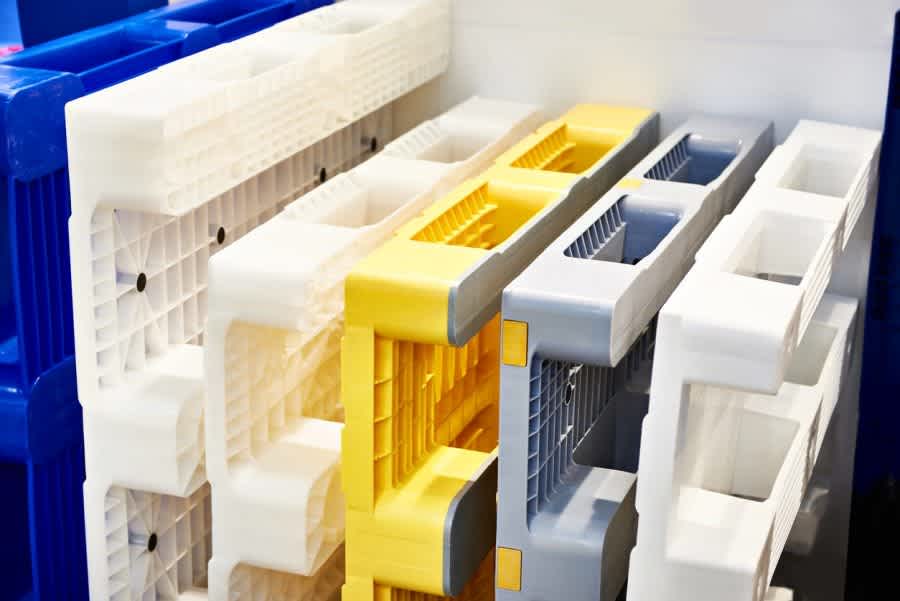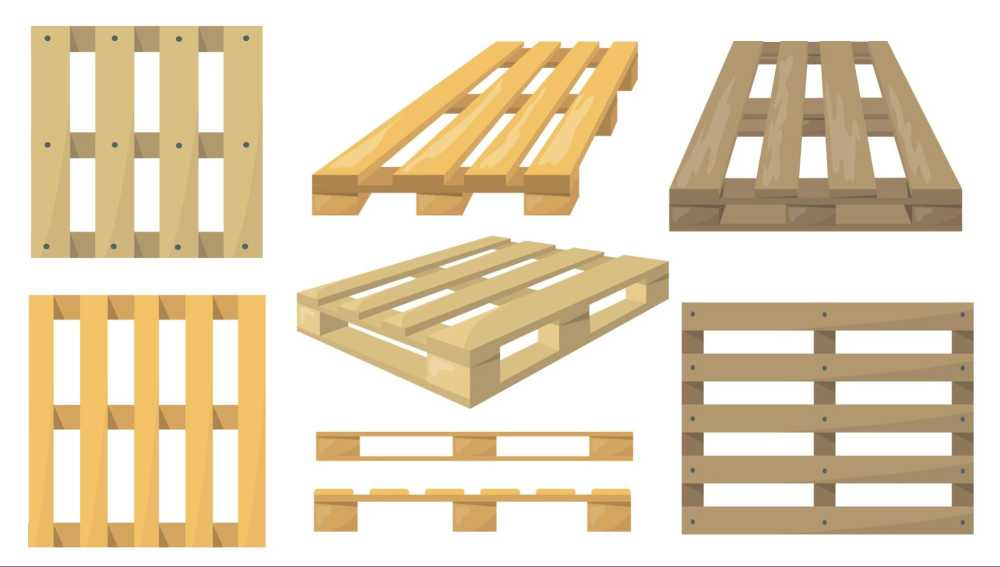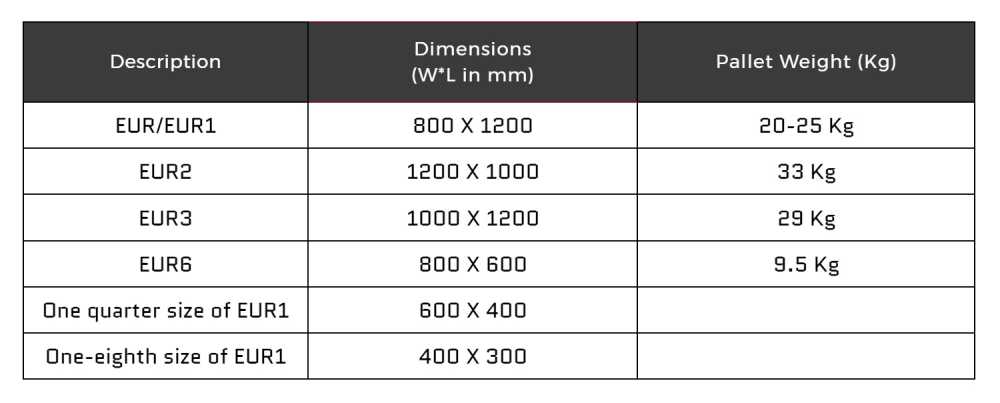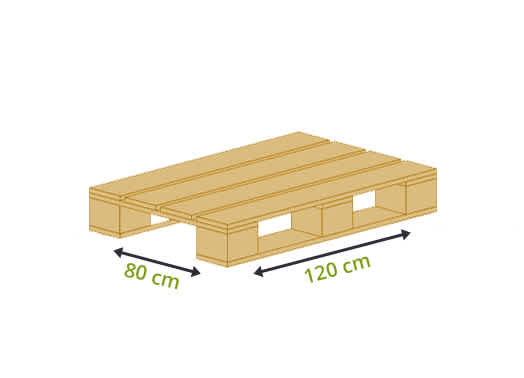
by Sam Franklin | June 22, 2022 | 9 min read
The eCommerce merchant’s guide to Euro pallets
Get fundedLast updated: July 08, 2022
Pallets are a fundamental part of the supply chain. According to a UN report, it was estimated that there were over 4 billion pallets in use across Europe alone in 2016. The most common form is the four-way block pallet since it is accessible from all sides.
There is no one globally dominant pallet size despite efforts by world freight players and regulators to standardise this industry.
The three main pallet standards are the Euro pallet (EPAL), International Standards Organisation (ISO) pallets and the North American Standard Pallets, also known as GMA (Grocery Manufacturers Association).
With global transport costs escalating due to the rising cost of inputs (e.g., fuel) and geopolitical conflict, optimising pallet use is ever more critical. This guide will take you through a few facts to keep in mind if you use Euro pallets.
Table of contents
- What are European pallets?
- The main materials used for Euro pallets
- How to choose Euro pallets for your eCommerce shipments
- Euro pallet vs standard pallet: what is the difference?
- Euro pallet regulations to keep in mind
- Frequently asked questions
What are European pallets?
Euro pallets are pallets that are predominantly used in Europe. They date back to the 1960s when European railway companies collaborated to develop a standard pallet to ease cargo loading.
The European Pallet Association (EPAL) was founded in 1991 to oversee standardisation and push for quality control. It follows a strict set of specifications. These include pallet sizes, design, type, number of nails per pallet, and timber used.
EPAL standardisation has enabled pallet pooling, simplifying freighting of goods while keeping shipping costs affordable. Standardisation also enables pallet repairs.
Makers of pallets that meet EPAL requirements are authorised to use their logo. The logo eases identification when making logistical, loading and repair decisions.

Subsequently, EPAL’s wood euro pallets must meet preservation thresholds set by the International Standard for Phytosanitary Measure No. 15 (ISPM15).
The main materials used for Euro pallets
In Europe, you will find pallets in two main materials. These include:
Wooden pallets
Wood is the most widely used material in the manufacture of Epals. Over 90% of pallets used in Europe are made from wood, mainly since it is an easily available material. Plus, it is cheaper and easy to repair, recycle or reuse compared to alternatives such as plastics and steel.

What could go wrong?
The tradeoff with using wooden pallets is that they are heavier than the plastic euro pallet. That makes the average running fuel costs much higher. Additionally, wood breaks easily and needs frequent repairs, not to mention the difficulties in cleaning.
When wood comes into contact with water or in humid or damp conditions, it gets easily infested, rots or smells. Rotten parts easily break. Such drawbacks make using wooden pallets a huge headache in controlled industries like food, beverages, and pharmaceuticals.
Plastic pallets
The use of plastic materials for pallets is accelerating as modern technology helps them become more competitive.

Plastic pallets have certain advantages over wood. These include:
The material is much lighter, lowering overall freight costs.
They are less prone to breakage on multiple trips.
Plastic is more hygienic and is nonabsorbent.
Plastic is easy to clean between and after use making it ideal for businesses in the consumables sector.
Since plastic is highly malleable, it's easy to customise and mould to different shapes, designs, and colour types.
Plastic pallets are sturdy and have a longer lifespan than wood types. This makes these pallets handy for industries or businesses that frequently move products.
The single main disadvantage of plastic pallets is the huge upfront cost.
Key dimensions: Euro pallet size
Broadly, there are six dimensional categories of the Euro pallet – starting with the standard size down to quarter pallets (for small traders).
The two most used standard Euro pallet dimensions are the EUR/EUR1 and EUR2.
The EUR1 has a dimension of L-1200mm, W-800mm and H-144mm. It weighs 20-25kg.
The EUR2 is 1000mm long, 1200mm wide and 144mm high, weighing about 33-35kg.
The EPAL can support a weight of about 1,500kg and up to 4,000kg for static loads.
The table below tabulates the EPAL categories, corresponding euro pallet dimensions, and expected weight.

EUR/EUR1 has the greatest application across Europe. However, smaller pallets are gaining traction due to adoption by smaller retailers.
Measurements (L*W)

NB: The UK widely used the 1200mm*1000mm pallet size, but this has transitioned to the EPAL.
How many Euro pallets fit in a container?
Freight containers range in sizes from 10 feet to 45 feet. The most widely used are the 20 and 40 feet shipping containers.
A 20 feet container measures 5.9m in length, 2.35m in width, and 2.39m in height. Approximately eleven pallets (EUR1/ISO1 800mm*1200mm) and ten 1200mm*1000mm EUR2/ISO2 pallets can fit in a 20-foot container.
A 40-foot container measures 12.03m in length, 2.35m in width, and 2.39m in height. 23-24 EUR1/ISO1 and 20-21 EUR/ISO2 pallets fit in a 40-foot container.
How to choose Euro pallets for your eCommerce shipments
To maximise returns from your shipments, you must be careful of the type of pallets you use.
Two main factors to consider:
Do not rely on pallet price!
As a business owner or supply chain manager, you must understand that, even though pallets impact overall transport costs, they should not rely solely on price to inform load strategy.
Pallet strength, functionality, and durability in relation to the goods are technically more important than the pallet price. High-quality pallets are durable, break less, and have a longer usable life. These benefits can translate to long-term profitability than mere upfront savings.
Other key factors to consider
The right pallet size impacts the immediate and long-term logistic costs. Size determines the number of packages you can load in a container or store in a warehouse. Check out this pallet size guide to help you identify how many pallets you need relative to the container size.
Optimal loading and the right pallet size-to-volume ratio prevents you from transporting air. It minimises damage to goods due to overloading and limits mishandling, loss, or damage during on and offloading. Appropriate pallets might also significantly lower the chances of injury to load handlers.
In totality, selecting the suitable pallets in relation to the products being moved will ultimately lower fuel consumption during transport.
Pallets contribute a significant portion of the shipping costs. So when making logistical decisions, it is tempting yet erroneous to use the price of pallets as the primary factor. The price of the pallet is a necessary but not sufficient consideration.
Euro pallet vs standard pallet: what is the difference?
ISO has tried to achieve the standardisation of pallets used in global trade, similar to what Europe attained with EPAL. Unlike EPAL, widely sanctioned in Europe, ISO (Standard) pallets are largely just a set of recommendations.
The table below displays the EPAL and ISO dimensional similarities and differences. The fourth column outlines the areas where the standard pallet size is mostly used.

Note that the dimensions of EUR/EUR1 correspond to those of ISO1. Those of EUR2 correspond to those of ISO2.
Exporters in the European region should appreciate pallet sizes of external target markets so they can plan supply chain requirements accordingly.
Similarly, a business importing from non-European markets should utilise the pallet dimensions of the area of origin to estimate the shipment implications.
You may need to use larger containers when shipping goods from Europe to other parts of the world using EUR1 and EUR2 pallets. Thus, you will encounter higher rates as a European exporter to cater to additional needs.
Euro pallet regulations to keep in mind
The European Pallets Association has a comprehensive guide that outlines Euro pallet standards and regulations.
EN 13626 outlines general requirements for packaging box pallets.
EN 13382 provides the dimensions.
EN 13698-1 contains production and construction standards.
All EPAL manufacturers must acquire a valid EPAL licence granted after a site inspection.
The regulations also govern the manufacture, repair, and marking of Euro pallets.
Manufacturing must adhere to the requirement stipulated in UIC Code 435-2.
Repair guidelines are provided in UIC Code 435-4.
If a board is damaged and/or has defects such as broken, cracked, or twisted appearance, has visible nails or screws, or a board is missing altogether, such a pallet is not suitable for use.
Mandatory marking of the pallet with the EPAL approval symbol is done on the left, centre, and right blocks.
All wood used to manufacture EPALs must be heat or chemical treated to control pests as per ISPM No. 15 requirements.
Treated wood must bear the appropriate symbol.
Final thoughts
This guide shows you all you need to know about using Euro pallets. With these tips about varying pallet sizes, costs, and regulations, you can make more conscious decisions and save money on your shipments.
Frequently asked questions
Can any warehouse handle Euro pallets?
Generally speaking, yes. Any warehouse should handle the standard EUR/EUR1 and EUR2 pallets. The standard size of these EPALs is 800mm*1200mm and 1000mm*1200mm, respectively, corresponding to ISO1 and ISO2 standards.
By extension, pallets of lesser dimensions than EUR1 and EUR2 should be comfortably handled in any warehouse. Additionally, the four-way block design of the pallet is versatile. It’s easy to move around using lifting equipment in today’s warehouses.
Why are pallets important?
In logistics and supply chain management, the use of pallets helps optimise space use and minimise shipping costs. Pallets also ensure the safety of products and that of load handlers.
Are European pallets the same as standard pallets?
The dimensions of EUR/EUR1 pallets and ISO1 pallets are the same, measuring 800mm*1200mm. The same applies to EUR2 and ISO2 pallets that measure 1000mm*1200mm and 1200mm*1000mm, respectively.
For other categories of EPAL and ISO pallets, the dimensions differ. Always refer to shipping guides for specific standard/euro pallet dimensions.
What is the main material used to make Euro pallets?
Over 90% of EPALs are made from wood. But plastic pallets are gaining momentum due to advances in production methods that lower acquisition costs.
Are Euro pallets reusable?
In practice, pallets are reusable. With proper maintenance, authorisation, and recommended repairs, wood pallets have an estimated useful life of 5-7years. Plastic pallets last much longer.
Written by

Sam founded his first startup back in 2010 and has since been building startups in the Content Marketing, SEO, eCommerce and SaaS verticals. Sam is a generalist with deep knowledge of lead generation and scaling acquisition and sales.


